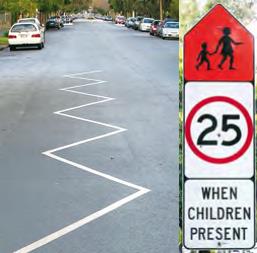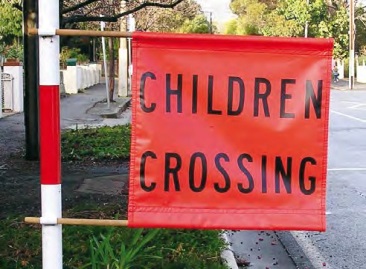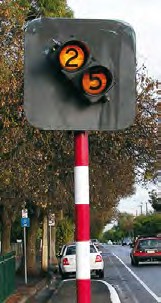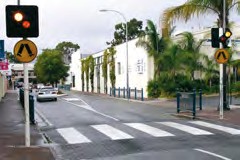Keep Kids Safe - a guide to traffic safety around schools
School Zones
School zones are installed on most roads around schools - as shown by these signs. A zigzag white line is also usually marked on the road to let drivers know they are approaching a School Zone.
Drivers must not exceed 25km/h at any time of the day or night when a child is in the zone. This includes children walking or riding a bicycle either on the road, footpath or median strip.
The lower speed limit applies whenever children are in the zone, including weekends and school holidays.
It makes sense to slow down as you approach a school at all times of the day and night to check if there are children in the area. Children can be present outside of normal school hours because of many activities that take place in the school.
Emu Crossings
An Emu Crossing has a red ‘Children Crossing’ flag displayed on red and white striped posts. When the flags are displayed drivers must give way to pedestrians crossing or about to cross the road.
Emu crossings are located within School Zones, which have a speed limit of 25km/h when
children are on the road or footpath.
If the ‘Children Crossing’ flags are not up, the 25km/h school zone speed limit still applies if there are children present.
Koala Crossings
A Koala Crossing consists of two yellow flashing lights mounted on red and
white striped poles.
Koala Crossings operate only when the yellow lights are flashing. A 25km/h speed limit applies between signs on the approaches to the crossing when the lights are flashing, and drivers must stop and give way to anyone using the crossing or about to cross the road.
School monitors may be present at the crossings and it is important to obey the Stop signs used by the monitors.
Wombat Crossings
A Wombat Crossing consists of a wide road hump marked with thick white stripes.
A 40km/h speed limit applies at all times within 30-40 meters of the crossing as shown on signs.
When a pedestrian is crossing or about to cross the road, drivers must stop and give way.
Parking Signs
No Stopping Signs
You must not park or stop in a No Stopping area for any reason.
No Parking Signs
You can only stop in a No Parking area for the immediate purpose of picking up or dropping off passengers or goods. The driver must remain with the vehicle and take no more than 2 minutes.
Parking Restrictions
Near school crossings
Parking is generally banned at school or other pedestrian crossings for 20 meters before and 10 meters after the crossing, unless signs indicate otherwise.
It is important not to park near crossings as it can make it harder to see children and other pedestrians using the crossing.
Double Parking
It is illegal to ‘double park’ by stopping next to another car already parked near the kerb. Double parking restricts access for other traffic and can block sight lines for children on the side of the road.
Parking Across Driveways
You should not park across a driveway. Restricting access to driveways is illegal and can inconvenience the property owners.
Continuous Yellow Line
A continuous yellow line marked on the edge of the road has the same meaning as a no stopping zone.
No parking allowed at any time if there is a yellow line.
Parallel Parking
Unless there are signs or markings on the road to indicate some other method, you must park parallel to the edge of the road and footpath.
The rules are:
- Park your vehicle so that it is facing in the same direction as the moving traffic.
- Unless permitted by a parking sign, leave a minimum of 3 meters between your vehicle and any continuous dividing line
